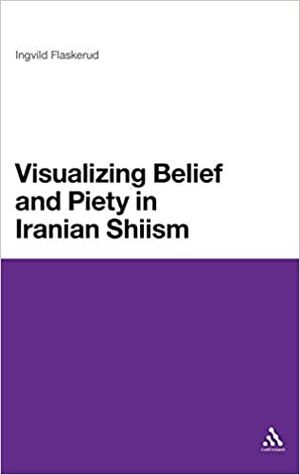Visualizing Belief and Piety in Iranian Shiism
The book Visualizing Belief and Piety in Iranian Shiism analyzes artistic dimensions of the rich devotional life of the Shi'i community active in Iran at the turn of the twenty-first century.
 | |
| Author | Ingvild Flaskerud |
|---|---|
| Language | English |
| Published | 2012 |
| Publisher | Bloomsbury Publishing India Private Limited |
| Pages | 320 |
About the authorEdit
Ingvild Flaskerud is Post-doctoral Fellow at Uni Global, the University of Bergen, Norway. Trained as an historian of religion, she has done extensive ethnographic field research among Twelver Shia communities in Iran and Northern Europe. Her research on Islam discusses various aspects of Islam as lived religion with particular attention to the agency of social interlocutors to examine how religion is experienced, practiced, negotiated, contested and formulated from within. At the Faculty of Theology, she is also involved in developing a new program in the study of Islamic theology, with attention to lived religion.
About the bookEdit
This book published in Continuum; Illustrated edition (June 21, 2012), has 320 pages and best sellers rank of 7,919,084 in Books.
The book is divided into three parts. Part I and Part II discuss the representation and reception of two popular genres: the portraiture of Imam Ali and the visual narration of the battle at Karbala. Since the images as invocation and thanksgiving are yet to receive proper attention part III addresses the functional aspect of images in devotional space.
Abstract of chaptersEdit
Part I - Imam Ali in PortraitureEdit
Chapter 1. The Emergence of a Prototypical Model and its Survival
This chapter traces the introduction of the single imaginary portraiture genre of Imam Ali into the Iranian society in the mid-nineteenth century and its dissemination into communal ritual life.
Chapter 2. Imam Ali in Shia Memory
This chapter analyzes local representation, reception and function of the imaginary portrait of Imam Ali that are grounded in the way Imam Ali has been conceptualized in Shia memory.
Chapter 3. The Iconography of Imam Ali and its Reception
This chapter concentrates on Imam Ali in contemporary portraiture and introduces a number of posters, paintings and wall hangings to analyze how Imam Ali is represented and discuss local receptions of the portraits.
Part II - The Battle of KarbalaEdit
Chapter 4. The Battle at Karbala in Shia Memory and Piety
This chapter introduces the Karbala event in Shia memory and piety.
Chapter 5. Visual Karbala Narratives in Shia Piety
This chapter traces the tradition of visual Karbala narratives since it developed in Iran in the nineteenth century.
Chapter 6. The Parcham Wall-hanging
This chapter discusses the visual vocabulary and symbolic meaning of contemporary wall hangings.
Chapter 7. Representation and Reception of Karbala in Color Posters
This chapter introduces a selection of color posters depicting scenes from the battle at Karbala. The selected images serve to illustrate the current range of motifs and offer examples of how a motif is rephrased into various designs.
Part III - Images and Decorative Designs in Ritual SpaceEdit
Chapter 8. The Image as a Votive Gift
This chapter discusses the image as a votive gift, and analyses the image as part of the reciprocal transaction characteristic of a votive process.
Chapter 9. Images in the Liturgy of Commemoration and Celebration
This chapter pursues the liturgical functions of images in ritual contexts to address the role of decorative programs and imageries in the liturgy of commemoration and celebration.
Chapter 10. Decorative Programs across Gendered Ritual Space
This chapter discusses tendencies concerning decorative programs and imageries across ritual spaces, comparing male and female run spaces and discussing factors that contribute to uniformity and diversity. Then analyzes the iconographic language in contemporary Iranian Shiism.
Chapter 11. Transposing Iconography
This chapter discusses some examples of transpositions of unconventional visual signs into the Shia iconography.